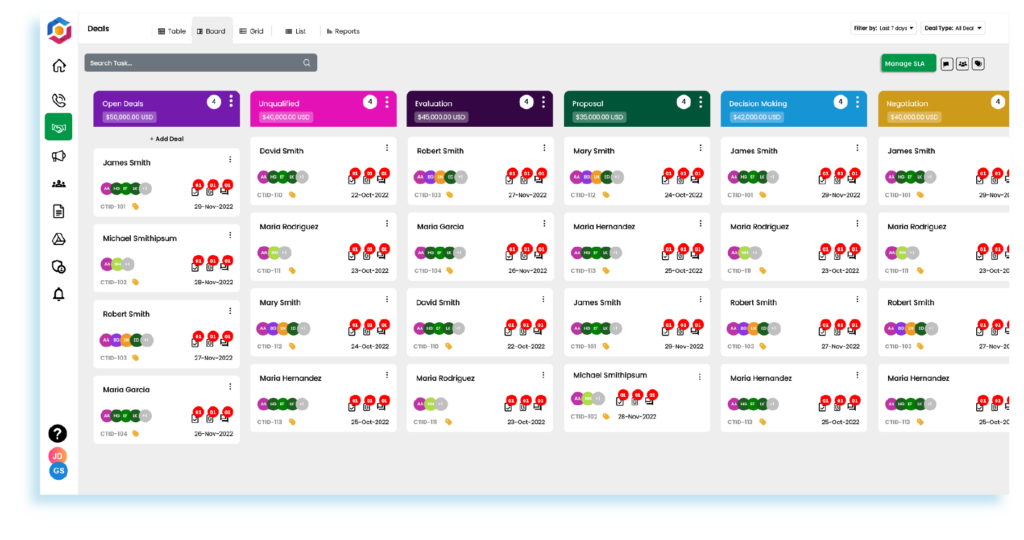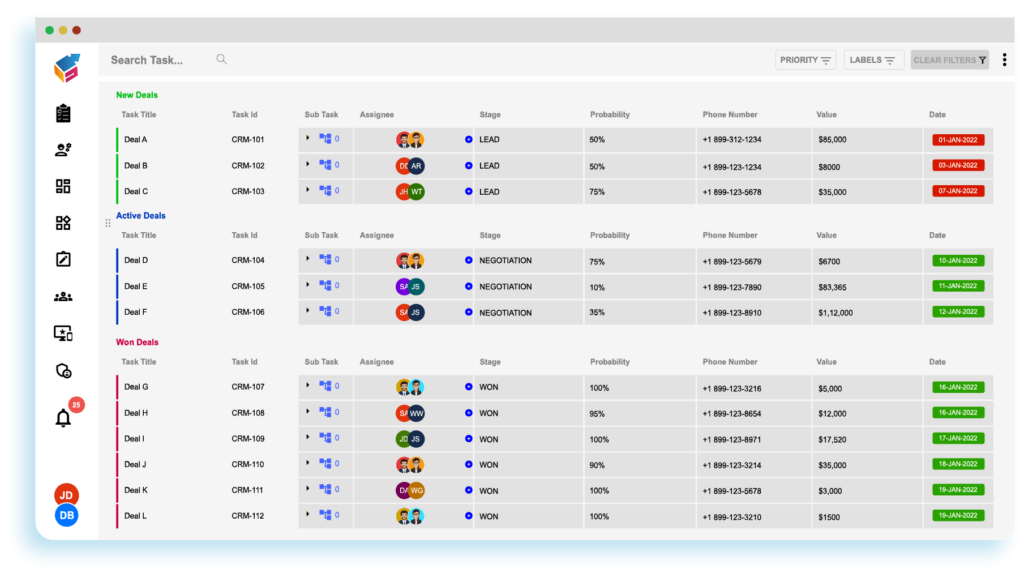What is a Sales Pipeline?
Sales pipeline stages are an important part of the sales process. It is a tool that helps sales representatives to organize and plan their activities.
Sales pipeline helps in understanding the current status of a sale and also allow for better forecasting of future sales.
A sales pipeline involves stages like prospecting, qualification, negotiation, closing, and follow-up, often repeated until the sale is closed. Enhance efficiency with CRM software, a well-defined sales plan, and a clear understanding of the conversion funnel.
What is Sales Pipeline Management?
Sales pipeline management is the process of managing a sales pipeline and ensuring it is in a healthy state. This includes the following:

The most common types of CRMs are:
- Determining which deals are in the pipeline and their status
- Setting goals for each stage of the sales process
- Tracking progress on deals in the pipeline
- Using data to identify opportunities for improvement
- Including stakeholders throughout the process
The Importance of a Well-Managed Pipeline
A well-managed pipeline is the backbone of a successful sales and marketing campaign. A pipeline is a series of steps that are taken to sell an offer to a prospect. It starts with the first contact and ends with the final close. The key is to have prospects move through your pipeline as quickly as possible, from start to finish.
In order for this process to work, you need to make sure that each step in your pipeline is properly managed. That way, you can be sure that your prospects are moving through at the optimal speed.
5 Strategies for Managing Your Sales Pipeline
Pipeline management is the core of any successful sales team. Sales pipelines are a representation of the sales process that helps keep track of how many prospects and leads in each stage, and how many deals closed in each stage.
In this article, we will cover five strategies that can help you manage your pipeline more efficiently.
Prioritize Your Leads:
The first step to managing your pipeline is prioritizing your leads. This will help you focus on the most promising opportunities first, so that you can close more deals and be profitable sooner.
Set Goals for Each Stage:
Sales pipeline is the backbone of any sales process. It’s the heart of your sales process management system that you use to track and manage your sales opportunities.
Use a CRM:
A CRM platform or customer relationship management system can help you stay organized by providing a centralized hub for all your data about your leads and prospects as well as their activities over time. It also makes it easier to prioritize leads because it provides visibility into which ones are most likely to convert into customers or clients.

Create a Sales Pipeline Report:
The next step in managing your pipeline is to create a report that shows all of the deals you’re working on, which ones have been closed, and which ones are still open. This way you can see what deals are most important and what deals need more attention.
Create a Sales Pipeline Plan:
Finally, you’ll want to create a plan for each stage in the pipeline so that everyone knows what their responsibilities are at each stage of the sale. You want to make sure that everyone is on the same page with their roles so that no opportunity falls through the cracks.
Tips for Managing Your Sales Pipelines at Scale
There are a few things you can do to manage your sales pipeline at scale.
- Create an editorial calendar and plan ahead of time using sales management software. This will help you segment your prospects into groups that are easier to manage and prioritize.
- Use sales templates for various stages of the sales process, such as the discovery phase or the close phase, so that you always have a template ready to go for any stage of the sales process.
- Don’t be afraid to send follow up emails if someone doesn’t get back in touch with you after a specific time period, but be mindful not to come across as pushy or too eager.
- If possible, try and schedule calls at least two weeks in advance so that they don’t conflict with other meetings or events in order to maximize your productivity.
What are the Best Practices in Creating a Successful Sales Funnel?
The sales pipeline is a critical aspect of any business. It determines how much revenue the company will bring in and how many customers they will acquire. A well-designed sales management software can help you achieve your goals and keep track of the progress you make.

There are three main steps to an effective sales pipeline: prospecting, qualification, and conversion.
For this section, I will be talking about best practices in creating your sales funnel.
The best practices for creating a successful sales funnel starts with understanding the buyer’s journey.
A sales funnel is an online marketing tool that is used to guide potential customers through a multi-step purchase process. It does this by providing information about the product, such as its features and benefits, and also by giving them the opportunity to purchase it.
A well-designed sales funnel can help you increase your conversion rates and get more people to buy your product or service. It can also be used to measure how well your marketing campaign is performing.
Benefits of Managing Sales Pipeline
Sales pipeline management is a critical component of sales process. It is used to monitor the progress of sales opportunities and estimate the probability of closing them.
A good sales pipeline will provide a clear view on the performance of your company, help identify opportunities and challenges, and allow you to see what needs to be done next.
The benefits of managing your sales pipeline are:
- A better understanding of the CRM pipeline
- A more efficient way to sell
- Better forecasting
- More accurate reporting
How to Manage Sales Pipeline Effectively?
Sales pipeline management is a process of understanding the customer needs, mapping the customer journey and making sure that the sales team is following up on each and every lead with the help of sales management software.
Sales pipeline management is an important part of any company’s success.
The sales pipeline should be monitored closely to make sure that there are no gaps in the process and to see if there are any opportunities for improvement.
Get a free demo to experience the latest features in sales management software!




